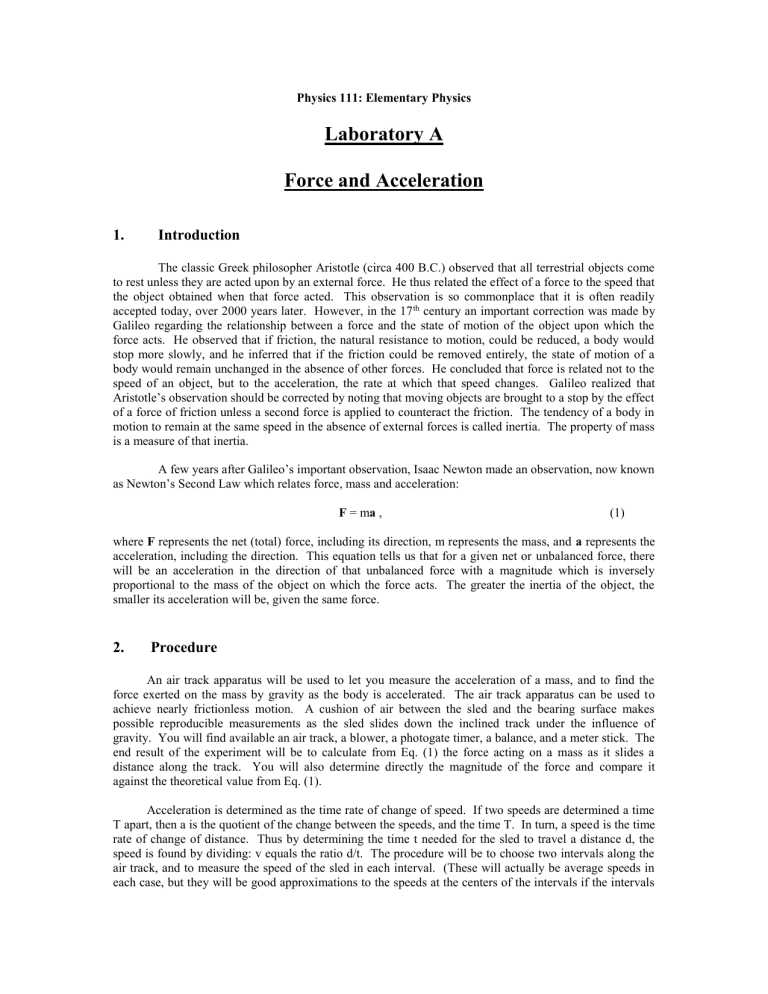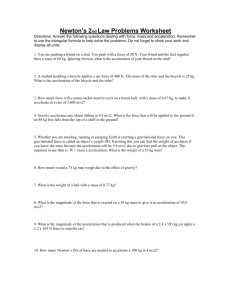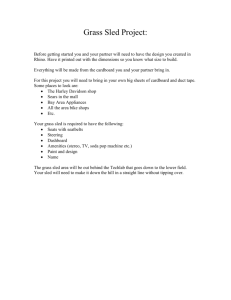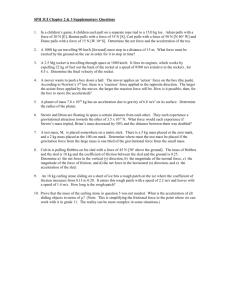Physics 111 Elementary Physics

Physics 111: Elementary Physics
Laboratory A
Force and Acceleration
1. Introduction
The classic Greek philosopher Aristotle (circa 400 B.C.) observed that all terrestrial objects come to rest unless they are acted upon by an external force. He thus related the effect of a force to the speed that the object obtained when that force acted. This observation is so commonplace that it is often readily accepted today, over 2000 years later. However, in the 17 th century an important correction was made by
Galileo regarding the relationship between a force and the state of motion of the object upon which the force acts. He observed that if friction, the natural resistance to motion, could be reduced, a body would stop more slowly, and he inferred that if the friction could be removed entirely, the state of motion of a body would remain unchanged in the absence of other forces. He concluded that force is related not to the speed of an object, but to the acceleration, the rate at which that speed changes. Galileo realized that
Aristotle’s observation should be corrected by noting that moving objects are brought to a stop by the effect of a force of friction unless a second force is applied to counteract the friction. The tendency of a body in motion to remain at the same speed in the absence of external forces is called inertia. The property of mass is a measure of that inertia.
A few years after Galileo’s important observation, Isaac Newton made an observation, now known as Newton’s Second Law which relates force, mass and acceleration:
F = m a , (1) where F represents the net (total) force, including its direction, m represents the mass, and a represents the acceleration, including the direction. This equation tells us that for a given net or unbalanced force, there will be an acceleration in the direction of that unbalanced force with a magnitude which is inversely proportional to the mass of the object on which the force acts. The greater the inertia of the object, the smaller its acceleration will be, given the same force.
2. Procedure
An air track apparatus will be used to let you measure the acceleration of a mass, and to find the force exerted on the mass by gravity as the body is accelerated. The air track apparatus can be used to achieve nearly frictionless motion. A cushion of air between the sled and the bearing surface makes possible reproducible measurements as the sled slides down the inclined track under the influence of gravity. You will find available an air track, a blower, a photogate timer, a balance, and a meter stick. The end result of the experiment will be to calculate from Eq. (1) the force acting on a mass as it slides a distance along the track. You will also determine directly the magnitude of the force and compare it against the theoretical value from Eq. (1).
Acceleration is determined as the time rate of change of speed. If two speeds are determined a time
T apart, then a is the quotient of the change between the speeds, and the time T. In turn, a speed is the time rate of change of distance. Thus by determining the time t needed for the sled to travel a distance d, the speed is found by dividing: v equals the ratio d/t. The procedure will be to choose two intervals along the air track, and to measure the speed of the sled in each interval. (These will actually be average speeds in each case, but they will be good approximations to the speeds at the centers of the intervals if the intervals
are short.) A measurement of the time for the sled to pass from the midpoint of the higher interval to the midpoint of the lower interval will give a value for T which you can then use to calculate the average acceleration, the ratio of the change of speed to the time interval, ∆v/T.
The air track is sketched above. (The blower and the pipe have been omitted.) The first step in the experiment is to determine the magnitude of the force which will cause the sled to accelerate down the incline. The forces which act on the sled are the reaction force of the air track and the weight of the sled, i.e. the force on the sled due to gravity. These forces are sketched at the right. The reaction force, R, acts perpendicularly upward from the air track to counter the component of the weight, W, acting perpendicularly to the track. Thus R equals Wcosθ, where θ is the angle of inclination of the track. The remaining, unbalanced component of W parallel to the track has magnitude Wsinθ, and causes the acceleration down the track.
Step by step instructions:
1. Use a meter stick or caliper to measure the elevation, ∆h, of a length, L, along the air track. Record these values and calculate sinθ.
2. Use the balance to measure the mass, m, of the sled. Record m and calculate W, and find a value,
F exp
, for the accelerating force.
3. In order to measure the lengths of the time intervals, t and T, you will use a pair of photogate timers.
An auxiliary timer is attached to a main timer by wires in a cable. The main timer is placed at the upper end of the length along which the air track sled is to move, and the auxiliary timer is placed at the lower end. The level of the timers is set so that the light beams in the timers will be broken as the air track passes by. The main timer is set on the Pulse option. The time displayed on the main timer is then the length of time between the instant the beam in the main timer is broken to the instant when the beam in the auxiliary timer is broken.
4. Choose the two short intervals along the air track which you will use for the measurement of the acceleration. Record the lengths of each interval. Note that each interval must be larger than the sled length. Record also the positions of the midpoints of each interval. (Take interval 1 to be the higher one.) Use the timer to determine three values of the time needed for the sled to pass through each interval, and record the average value below. Calculate v for each case.
5. Place the timers at the midpoints of the two intervals and record three values of the time needed for the sled to pass between these positions. Record the average value as T, and calculate a. Use the value of the mass of the sled m, with your value for a to compute F theo
, using Eq.1.
6. Compare the magnitudes of F determined directly (in the first part of the experiment) and the theoretical value (in the latter part of the experiment) by calculating the percentage difference between them.
Physics 111: Elementary Physics
Pre-Lab Exercise
Force and Acceleration
Name
: _____________________
Section
: _______
1.
Some typical data from this type of experiment are given below. Fill in the blanks .
Inclination:
∆h = 3.58 cm
Accelerating Force: m = 37.8 gram
L = 1.00m
W = mg =
_______
sinθ = ∆h/L =
F exp
_______
= Wsinθ =
_______
Time Intervals and Average Times:
Interval 1
Timer positions 35.0 cm 45.0 cm
Interval 2
85.0 cm 95.0 cm
Distance Time Avg time Velocity
Interval 1. ________ 0.183 s 0.189 s 0.185s _______ v
1=
_______
Interval 2. ________ 0.133 s 0.128 s 0.125s _______ v
2=
_______
Time between midpoints: 0.751 s 0.757 s 0.752 s T avg
= _______
Acceleration = (v
2
– v
1
)/T avg
= __________ F theo
= ma = __________
∆F(%) = 100[|(F exp
- F theo
)|/F exp
] = __________
2.
Suppose you were able to measure all the quantities used in part 1 with unlimited accuracy. Would you expect F theo
and F exp to be identical ? If not, why not ?
3. State briefly (100 words or less) the objectives of this experiment and the hypothesis which is to be tested.
Physics 111: Elementary Physics
Lab Report
Force and Acceleration
Investigators:
________________________ , _______________________
________________________ , _______________________
________________________
Date:
_____________
Procedure
: Describe briefly (200 words or less) the procedures used in this experiment .
Data:
Inclination:
∆h =__________
L =__________ sinθ = ∆h/L = __________
Accelerating Force:
m = __________ W = mg = __________ F exp
= Wsinθ = __________
Time Intervals and Average Times:
Interval 1 Interval 2
Timer positions: __________ __________ __________ __________
Distance Times Avg time Velocity
Interval 1. _______ _______ _______ _______ _______ v
1
_______
Interval 2. _______ _______ _______ _______ _______ v
1
_______
Time between midpoints: _______ _______ _______ T = _______
Acceleration = (v
2
– v
1
)/T = ___________ F theo
= ma = __________
∆F(%) = 100[|(F exp
- F theo
)|/F exp
] = __________
Discussion:
Does the comparison of F exp
and F theo
support Newton’s Second Law ? Is the potential accuracy of the experiment improved or reduced if the angle of inclination is increased ? Hint: think about the measurement error in the times.






